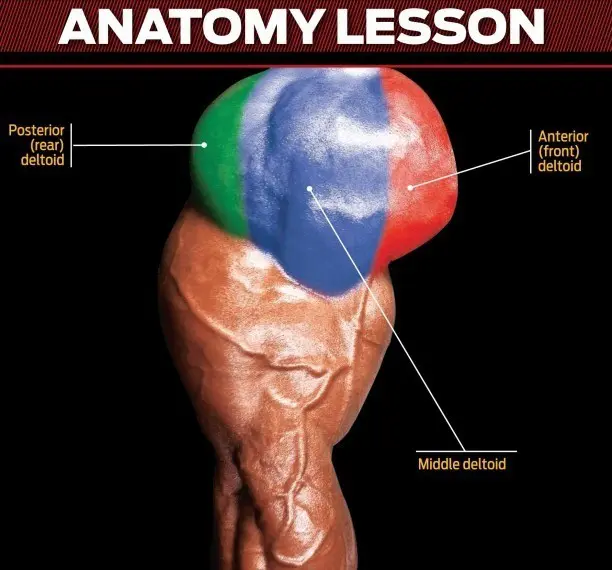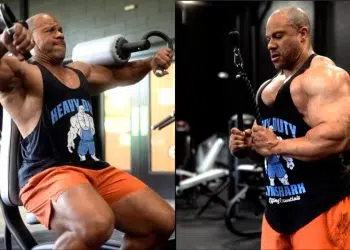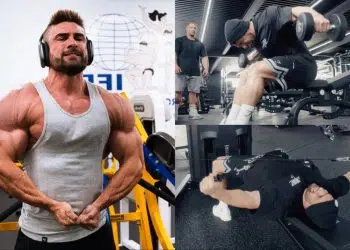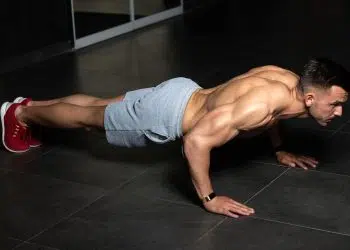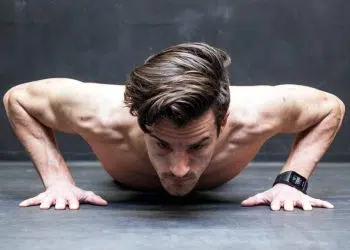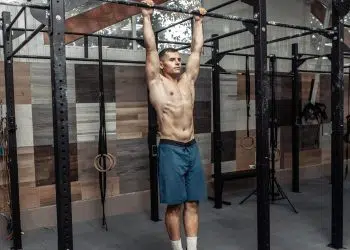Training at home doesn’t have to mean a steady diet of pushups, pullups, planks, and burpees. While there is nothing wrong with bodyweight training, if building muscle is your goal, you’ll get better results with free weights, and dumbbells are especially useful.
Dumbbells are smaller, more compact, and more versatile than barbells, and you can use dumbbells to train every muscle in your body. They also allow you to fix left-to-right muscle weaknesses, increase stabilizer activation and strength, and will also improve your balance. There is nothing dumb about dumbbells.
A pair of dumbbells is also all you need to build cannonball shoulders. Even if you only have one set, and they aren’t very heavy, you have the perfect delt-building tools. Work hard, and you can transform your shoulders into something you can be proud of!
Not sure where to start? No problem! Try our at-home dumbbell shoulder workout for size.
Shoulder Anatomy
Your shoulders, properly called the deltoids, are a three-headed muscle. They have several functions, and while all three heads usually work together, it’s also possible to emphasize each one with specific strength training exercises.
Level Up Your Fitness: Join our 💪 strong community in Fitness Volt Newsletter. Get daily inspiration, expert-backed workouts, nutrition tips, the latest in strength sports, and the support you need to reach your goals. Subscribe for free!
While you don’t need a degree in anatomy and physiology to build bigger shoulders at home with dumbbells, it may be useful to understand how your shoulders work so you can design your own shoulder workouts in the future.
The three heads of the deltoids and their functions are:
Anterior
The anterior deltoid is your front shoulder muscle. Its main roles are shoulder flexion and medial or inward rotation. It’s the most-active deltoid in overhead pressing movements and is also very involved in all chest exercises.
Medial
The medial deltoid is located on the side of your shoulder. Like a pair of shoulder pads, the medial deltoids give your upper body its width. The medial deltoids, also known as the lateral deltoids, are responsible for lifting your arm up and out to the side in a movement called abduction.
Posterior
The posterior deltoid is located on the back of your shoulder, and its main roles are shoulder extension and external rotation. An important postural muscle, the posterior deltoid is often overlooked and underdeveloped, which can lead to slouching and shoulder pain. Any good shoulder workout should include exercises for this muscle.
18 Best Dumbbell Shoulder Exercises
- Seated Dumbbell Overhead Press
- Reverse Flyes
- Dumbbell Upright Row
- Alternating Arnold Press
- Lean Away Single-Arm Lateral Raises
- Double Front Raises Against A Wall
- One Arm Dumbbell Swing
- Spellcaster
- Z Press
- 3-Way Shoulder Raise
- Renegade Row
- Single Arm DB Power Clean and Jerk
- Farmer’s Walk
- Incline Bench-Supported Y Raise
- Single Arm Incline Dumbbell Side Lateral
- Seesaw Press
- Dumbbell Shoulder Shrugs
- Seated Dumbbell Clean And Half-Press
1. Seated Dumbbell Overhead Press
Anyone looking to add size and strength to the shoulders should definitely include a seated dumbbell overhead press in their workout program.
This is a foundation movement that improves upper body strength. Performing overhead press in a seated position blocks the lower body from assisting the lift.
How to do it:
- Grab a pair of dumbbells with a neutral grip and sit on a bench.
- Hold the dumbbells at shoulder height with palms facing forward.
- Exhale and extend your elbows to push the dumbbells in the overhead position.
- Inhale as you slowly lower the dumbbell down to starting position.
- Repeat for the recommended number of reps.
Pro tip: It’s always better to perform this exercise with an incline bench set at 80 degrees. Keep your torso tight, and do not overarch the back. Slow down the eccentric portion for maximum hypertrophy.
Muscle worked: Front deltoids, triceps, trapezius, chest, and core.
2. Reverse Flyes
This exercise targets your posterior deltoids, middle trapezius, and rhomboids. These muscles are crucial for shoulder health and posture. While your posterior deltoids are definitely shoulder muscles, they tie into your upper back. They can add a lot to your physique when viewed from behind.
How to do it:
- With a dumbbell in each hand, stand with your feet about shoulder-width apart, knees slightly bent. Lean forward from your hips until your upper body is about parallel to the floor. Let your arms hang straight down from your shoulders, palms facing inward.
- Open your arms and lift the dumbbells up and out to the side to form a T-shape. Do not use your legs or back to help you swing the weights up, and do not round your lower back either.
- Lower your arms and repeat.
- This exercise can also be performed seated, by leaning forward and resting your chest on your legs.
Pro tip: Squeeze each contraction for 2 seconds, it will bring more awareness to the muscle fibers and also boost the muscle pump.
Muscle worked: Rear delts, traps, and lower back.
3. Dumbbell Upright Row
Want superhero-like shoulders? Pay more emphasis on this exercise. It’s an excellent exercise to target the middle and rear shoulder heads. Additionally, it also engages traps, rhomboids, arms, and core.
One of the best things about this exercise is that it allows the lifter to go heavy, which results in greater hypertrophy and strength. Lifters who are looking to add size to the shoulders should definitely perform dumbbell upright rows.
How to do it:
- Stand with the feet shoulders width apart.
- Grab a moderate-weight dumbbell with an overhand grip.
- Keep your arms extended and your back straight. The dumbbells should be resting on the top of your thigh.
- Flex your elbows to bring the weight up close to the chest. Keep the dumbbells close to the body as you pull them up.
- Slowly bring the dumbbells back to the starting position.
Pro tip: Do not let the weight fall down. Focusing on the controlled eccentric phase will create hypertrophy.
Muscle worked: Medial delt, rear delt, traps, arms, rhomboid, and core.
4. Alternating Arnold Press
The Arnold press is named after bodybuilding superstar Arnold Schwarzenegger. This exercise mainly works your anterior or front deltoids but also hits your medial and posterior deltoids pretty hard too. The alternating arm action makes this exercise even more effective as it keeps your muscles under tension for longer. That’s very useful if you only have light dumbbells.
How to do it:
- Seated or standing, hold a dumbbell in front of your shoulders, palms facing you. Your elbows should be directly below your hands, and your forearms should be vertical.
- Keeping one arm stationary, extend your opposite arm and press the weight up and overhead. As you push your arm up, turn your wrists so, at the top of the movement, your palm is facing forward.
- Lower the dumbbell using the same movement in reverse. Swap arms and repeat.
- Continue alternating sides for the duration of your set.
Pro tip: Start with lightweight dumbbells, and keep the tempo slow and controlled.
Muscle worked: Front, medial, and rear delts, triceps, and core.
Related: Arnold Press Guide.
5. Lean Away Single-Arm Lateral Raises
Lean away side laterals work your medial or side deltoids. This exercise prevents you from cheating and also allows you to focus on one shoulder at a time so you can spot and fix any left to right imbalances. Leaning away places greater overload at the top of the movement, making each rep more effective.
How to do it:
- Hold a dumbbell in one hand and stand next to a sturdy doorframe, railing, pillar, or similar. Grip the frame/railing, etc., and lean away, so your body is slightly inclined. Let your other arm hang straight down, palm facing your leg.
- With your elbow slightly bent but rigid, lift your arm up and out to the side until it’s roughly parallel to the floor.
- Lower the weight and repeat.
- Do the same number of reps on each arm.
Pro tip: Pause for two seconds at the peak contraction to improve muscle activation and pump.
Muscle worked: Medial delts.
6. Double Front Raises Against A Wall
Front raises work your anterior deltoids as well as your upper traps. Big shoulders and traps go together like bacon and eggs and will give you a powerful-looking upper body. This exercise is often done using an alternating arm action. However, this can lead to swinging and cheating. Raising both arms at the same time and leaning your back against a wall makes cheating all but impossible and will make light dumbbells feel much heavier.
How to do it:
- With a dumbbell in each hand, stand with your back to a smooth wall. Lean back, placing your butt, upper back, and head against the wall. Rest and hold the dumbbells in front of your hips. Bend your legs and move them forward about two feet from the all.
- From this position, and with your elbows slightly bent but rigid, lift both arms forward and up until they are parallel to the floor.
- Lower the weights back down to your legs and repeat.
Pro tip: As you move the dumbbell forward, it challenges your body’s center of gravity. Keep the core braced throughout the movement. Keeping the tempo slow will push your training to another level.
Muscle worked: All three shoulder heads, traps, and core.
7. One Arm Dumbbell Swing
One arm dumbbell swing is a compound exercise that will allow you to target shoulders and the whole posterior chain. It’s a classic workout for someone who is looking to fire up the lower body while training shoulders.
Because of being a compound movement, one arm dumbbell swing torches a lot of calories and can also be utilized as a cardiovascular activity.
How to do it:
- Stand tall with feet at shoulder distance apart. Place a moderate-weight dumbbell between your feet.
- Bend your knees and push your hips back to grab the dumbbell with an overhand grip and hand fully extended. Keep your spine straight and scapula retracted.
- Extend the non-working arm to the side to make it work as a counterbalance to the movement.
- Start by swinging the dumbbell backward between your legs and then use the hip drive to push the dumbbell forward, bringing it to shoulder height.
- Let the dumbbell swing between your legs to shoulder height while creating an arch.
- Don’t pause and continue to swing the dumbbell for the recommended number of reps.
Pro tip: Keep the core tight and hand extended throughout the movement. Beginners should practice with light weights until they get comfortable with the new movement pattern. It’s a swing, so you should not be flexing your elbows to modify the movement.
Muscle worked: Shoulders, rhomboid, core, glutes, hamstrings, quad, and arms.
8. Spellcaster
Spellcaster is an exercise that primarily works on the core and shoulders. It might look unconventional, but it’s an excellent functional exercise that strengthens torso rotation.
Spellcaster allows you to develop a rotational and anti-rotation force that protects the spine from injuries. This exercise is especially beneficial for athletes in certain sports, such as baseball or golf.
How to do it:
- Stand tall with feet at shoulders width distance.
- Hold a lightweight dumbbell in each hand while keeping the arms extended. And knees slightly bend.
- Rotate your torso to bring the dumbbell to one side of the body.
- Swing both the dumbbell from one side to another side by rotating the torso and forming an arc.
- Continue alternating, rotating from one side to the other until the set is complete.
Pro tip: It’s important to keep your torso braced throughout the movement.
Muscle worked: Shoulders, serratus anterior, core, and traps.
9. Z Press
This exercise is named after the Lithuanian strongman sensation Žydrūnas Savickas. Z press is an excellent shoulders exercise that increases shoulder strength and size while working on core stability and hip mobility.
Doing this overhead shoulder press allows you to remove the involvement of leg drive while lifting. You can perform this exercise with one hand or both hands, it’s all up to you.
How to do it:
- Grab a pair of moderate-weight dumbbells with both hands in an overhand grip and sit on the floor with your legs spread wider and fully extended, forming a “V”.
- Bring the dumbbells to the front rack position.
- Keep your elbows forward and your torso perpendicular to the floor.
- Now push the dumbbell up to fully extend your arms in the overhead position.
- Slowly bring the hands down to the starting position.
- Repeat for the recommended number of reps.
Pro tip: If you are finding it difficult to get your torso perpendicular to the ground, then you need to work more on hip and hamstring mobility. Performing some lower body stretches should make body positioning easier.
Muscle worked: Front delts, triceps, and core.
10. 3-Way Shoulder Raise
3-way shoulder raise is an excellent movement that helps you target all three shoulder heads. As the name suggests, it is an exercise that incorporates lateral raise, horizontal adduction, and front raise.
How to do it:
- Grab a pair of dumbbells in each hand and stand with the feet at shoulder-width apart.
- Keep your arms fully extended, and your torso braced.
- Raise the dumbbell laterally to bring your arms parallel to the ground.
- Horizontally adduct your arms to bring them towards the center of your body.
- Flex your shoulders to raise the dumbbell up in the overhead position.
- Now reverse the sequence to bring the dumbbell back to starting position.
- This completes your one repetition. Repeat for the recommended number of reps.
Pro tip: Start with lightweight dumbbells. This is a multi-planar movement that is going to challenge the shoulders in a different way.
Muscle worked: All three shoulder muscles, core, and traps.
11. Renegade Row
Renegade row strengthens the shoulder, back, and core, all in a single movement. Renegade row is a combination of two upper body strength movements: a plank and a dumbbell row.
For the shoulders, renegade row will target the posterior delts and will enhance shoulder stability. When you lift one hand off the ground, your other arm has to work very hard to keep the body balance.
How to do it:
- Start in the top position of a pushup with your hands on dumbbells shoulder-width apart.
- Row one dumbbell toward the side of your body while balancing on the opposite hand and feet.
- Pause for one second at the top and return the weight slowly to the start position.
- Repeat on the other side.
Pro tip: Start with lightweight dumbbells and try not to rotate the torso as you row with one hand. Keeping the core tight, and stable will help you get the best benefits.
Level Up Your Fitness: Join our 💪 strong community in Fitness Volt Newsletter. Get daily inspiration, expert-backed workouts, nutrition tips, the latest in strength sports, and the support you need to reach your goals. Subscribe for free!
Muscle worked: Core, shoulders, traps, lats, and spinal erectors.
12. Single Arm DB Power Clean and Jerk
It’s a compound movement that will improve full body strength and explosiveness. Regularly practicing this movement will enhance muscular endurance, size, and coordination.
When performed with high reps, single-arm dumbbell power clean and jerk can prove to be an excellent fat burner exercise with added cardiovascular benefits.
How to do it:
- Keep your feet at shoulder width apart and place a dumbbell in between the legs.
- Slightly bend your knees and push your hips back to grab the dumbbell with one hand.
- Keeping your torso braces and your back straight.
- Use your hip drive to bring the dumbbell up to the front rack position.
- Slightly dip your torso by bending your knees.
- Rapidly extend your legs and press the dumbbell in the overhead position.
- Bring the dumbbell back to the starting position while maintaining full control.
- Repeat for the recommended number of reps.
Pro tip: It’s a complex movement, and beginners should be doing it under expert supervision.
Muscle worked: Glutes, hamstrings, quadriceps, shoulders, biceps, triceps, traps, and core.
13. Farmer’s Walk
Farmer’s walk is an underrated exercise, but that doesnt reduce its significance. It’s an excellent exercise that will help you develop stronger delts, traps, and core.
Farmer’s walk is a functional movement that will improve the efficiency of day-to-day movements. Farmer’s walk is an uncomplicated exercise that can be done almost anywhere. All you need is a heavy set of dumbbells or kettlebells to carry them around.
How to do it:
- Stand with your core tight and back straight.
- Retract your scapular blades and grab a pair of heavy-weight dumbbells with a neutral grip. Hold the dumbbells to the side of the body.
- Start walking with your core braced.
- Continue walking for the desired distance.
Pro tip: Squeeze the handles hard to improve muscle activation and allow yourself to cover a longer distance. If your grip strength is restricting your farmer’s walk, then use lifting straps to grip the dumbbells for a longer period.
Muscle worked: Traps, shoulders, erector spinae, arms, core, forearms, quads, hamstrings, glutes, and calves.
14. Incline Bench-Supported Y Raise
It’s a great exercise to target the rear delts.
How to do it:
- Set the bench at 45-60 degrees incline.
- Lie your chest down on the bench with a pair of lightweight dumbbells.
- Palms should be facing each other, and let your arms hang perpendicular to the ground.
- While keeping the arms fully extended, raise them straight out in front of the body to create a virtual Y with your body.
- Slowly lower the dumbbells to complete a rep.
Pro tip: Don’t try to go heavy. Practice with lightweight dumbbells. Squeeze the contraction for a second to get a better mind-muscle connection.
Muscle worked: Rear and medial delts.
15. Single Arm Incline Dumbbell Side Lateral
Single arm incline dumbbell side lateral allows you to isolate the medial deltoid unilaterally. Sitting sideways on an incline bench allows you to target the shoulders from a different angle for fuller and wider delts.
How to do it:
- Grab a lightweight dumbbell with one hand and hold it down to the side of the body.
- Sit sideways on an incline bench that is set between 60-70 degrees.
- Raise your arm laterally until it gets in a straight line to the shoulders.
- Lower the dumbbell very slowly to the bottom.
- Repeat for the recommended number of reps.
Pro tip: Keep the tempo slow and controlled.
Muscle worked: Medial delt.
16. Seesaw Press
Seesaw press is a great shoulder finisher that will not only improve strength but also provides a mindblowing muscle pump.
Some people might confuse the seesaw press with the alternating dumbbell press, but they both are different. While alternating dumbbell press allows you to rest one dumbbell on the shoulder while you lift the other dumbbell, the seesaw press maintains constant tension in the shoulders. You are not allowed to rest a dumbbell on your shoulder while you are pressing the other side. As you start to lower one hand, you lift the other hand, just like a seesaw.
How to do it:
- Grab a pair of moderate-weight dumbbells and stand with the feet at shoulders width apart.
- Flex your elbows to bring the dumbbells up at shoulder height. Keep your elbows pointing forward.
- Press one dumbbell over your head, and as you bring the dumbbell down, simultaneously press the other dumbbell in the overhead position.
- Alternate the pressing with both arms at the same time, just like a seesaw.
Pro tip: Keep your shoulders retracted and core tight throughout the movement.
Muscle worked: Front delts, triceps, and core.
17. Dumbbell Shoulder Shrugs
Although you may call it a part of a back workout, it will complement your shoulders by helping you develop a massive upper back. Dumbbell shoulder shrugs will help you develop stronger and bigger upper traps.
Shrugs allow you to go heavy while training, and shoulders work as a primary stabilizer muscle which indeed helps in gaining strength and size of shoulders too.
How to do it:
- Grab a pair of dumbbells with an overhand grip.
- Hold the dumbbells by your side with the palms facing inwards and arms fully extended.
- Keep your back straight, and core braced.
- Raise your shoulders up while contracting the upper trap.
- Hold the contraction for two seconds before letting the dumbbell go back to the starting position.
- Repeat for the recommended number of reps.
Pro tip: While keeping the spine straight, bend forward by just ten degrees to improve the trap activation. Concentrate on squeezing those traps hard.
Muscle worked: Upper traps, shoulders, arms, forearms, and core.
18. Seated Dumbbell Clean And Half-Press
This shoulder exercise will leave all three deltoids pumped and tired. Doing a half-press might feel like cheating, but it’s an excellent way to keep the tension on your delts. It is widely used as a workout finisher, so crank out as many reps as you can. Go for it!
How to do it:
- Sit on a chair or bench with a dumbbell in each hand and your feet flat on the floor. Let your arms hang down by your sides, palms facing inward.
- Lean forward slightly from your hips and without rounding your lower back. Quickly sit up straight, using this momentum to help you raise the weights to shoulder height, palms still facing inward.
- From your shoulders, press the weight up to just above head-height – the half-press.
- Lower your dumbbells to your shoulders and then to your sides before repeating.
Pro tip: Keep the core tight throughout the movement.
Muscle worked: Core, shoulders, biceps, triceps, traps, and spinal erectors.
Dumbbell Only Shoulder Workouts
Every individual has different fitness goals, and you can not have a generic training program for every goal. We can broadly categorize your training into two parts: bulking and cutting.
For The Bulking Phase
We designed this dumbbell-only shoulder workout to maximize the size and strength gains. This workout focus on high volume. Let’s have a look:
| Exercise | Reps | Sets | Rest period | |
| 1. | Seated overhead dumbbell press | 8-10 | 4 | 90 secs |
| 2. | Dumbbell upright row | 8-10 | 4 | 60 secs |
| 3. | Seated dumbbell clean and half press | 6-10 | 3 | 60 secs |
| 4. | Dumbbell reverse fly | 10-12 | 3 | 60 secs |
| 5. | Incline bench supported Y raise | 10-12 | 3 | 90 secs |
| 6. | Farmer’s walk | 30 secs | 4 | 90 secs |
For The Cutting Phase
In the cutting phase, your primary focus should be on better muscle definition and pump. As you are on a caloric deficit diet, workout volume should be moderate.
| Exercise | Reps | Sets | Rest period | |
| 1. | Alternating Arnold press | 8-10 | 4 | 90 secs |
| 2. | Lean away single arm lateral raise | 10-12 | 3 | 60 secs |
| 3. | Z press | 10-12 | 3 | 60 secs |
| 4. | 3-way shoulder raise | 8-10 | 2 | 60 secs |
| 5. | Dumbbell shoulder shrugs | 12-15 | 3 | 90 secs |
Benefits of Shoulder Workout with Dumbbells
Eliminate The Strength Imbalance
Do you have a stronger and weaker side? Including dumbbells in the training routine is the best way to handle the muscle strength imbalance.
When you hold a dumbbell in each hand, both sides must exert equal force to coordinate the lift, thus correcting the strength imbalance. Additionally, dumbbells facilitate unilateral training, which allows you to focus on one side at a time.
Core Activation
Dumbbells allows various unilateral movement that improves muscle isolation and increases core activation. As you do a single-arm dumbbell press, your core has to work hard on its anti-rotational strength.
Various movements like a spellcaster, renegade row, or one-arm dumbbell swings require extensive core engagement.
Freedom Of Movement
With the dumbbells, you can freely rotate your wrist or change the hand positioning to target the muscle fibers differently.
Example: Arnold press, where you rotate your wrist to alternate between a pronated and supinated grip. Performing multi-planar movements are convenient with dumbbells.
More Muscle Activation
Freedom of movement provided by dumbbells increases muscle engagement. As you must balance two weights simultaneously, arms need to work harder to maintain coordination and synergy. Plus, your core needs to work harder too.
A 2011 study compares muscle activation while performing a barbell bench press, a smith machine bench press, and a dumbbell bench press. Training with dumbbells engaged maximum muscle fibers. [1]
Things To Consider For Shoulder Workout
Always Warmup
This should be the first thing you need to take care of. Shoulders are critical and complex joints that connect a lot of muscle fibers. While most muscles are either developed to pull or push, shoulder muscles do both, making it more important to focus on the proper warmup.
Working on reinforcing the mobility at the shoulder joint and scapula stability can certainly help! Some of the best mobility drills includes: standing arm swings, shoulder pass through, band pull-aparts, and dips.
Reserve Isolation Exercises For End
Compound movements are performed best when the muscles have optimum glycogen reserves. Compound movements help in building strength, and the stronger you get, the more efficient your muscle isolation becomes.
Rearrange Your Workout
The majority of the guys start their shoulder workout with front delts and end with rear delts. By the time you start to train those rear delts, they are already exhausted.
Rearrange your workout to emphasize more on the weaker part. If your rear delts are weaker than the front delt, then it’s time to start your shoulder workout with the rear delt focusing exercise. You can start with the upright row or reverse fly to emphasize more on the development of rear delts.
FAQs
Do you have any questions about this home dumbbell shoulder workout? We’ve got answers! If you can’t find the information you are looking for below, drop us a line in the comments section, and we’ll get back to you as soon as we can.
How often should I do this at home dumbbell shoulder workout?
For best results, do this work out once or twice per week. If you choose twice, do it on non-consecutive days, e.g., Monday and Thursday, to allow plenty of time for recovery. Also, try and keep your shoulder and chest workouts separated by a day to two. Why? Because both workouts involve your triceps and anterior deltoids and doing them back-to-back could lead to overtraining and poor performance during the second workout.
My rear delts are weak. What other exercises can I do for them?
For home workouts and training in general, one of the best rear delt exercises you can do is band pull-apart. All you need is a resistance band. Hold the band up at shoulder-height with your elbows straight. Open your arms and stretch the band out across your chest, pulling your shoulders down and back as you do so. Return to the starting position and repeat. Do a few sets of 12-20 reps every other day to quickly bring your posterior deltoids up to strength.
I don’t have any dumbbells. What is a good bodyweight shoulder exercise?
All types of push-ups and dips involve your deltoids. Still, if you specifically want to target this muscle, you need to invert your body to replicate overhead presses. You can do handstand push-ups or, more conveniently, pike push-ups. Adopt the standard push-up position, but then lift your butt into the air, so your body resembles an inverted V. Bend your arms and lower your head to the floor, and then push back up again. Use a slightly wider-than shoulder-width hand placement for best results.
Is the at home shoulder workout the only training I need to do?
While your deltoids are a vital muscle group, you should not neglect the rest of your body. Your legs, chest, and back are equally important. This workout is designed to be part of a split routine, where you train different muscle groups on different days. While it’s okay to emphasize your shoulders, don’t neglect the rest of your body. Here are some bodyweight-only home leg workouts to get you started.
I’ve only got light dumbbells. Can I still build muscle?
When it comes to building muscle, most people tend to graduate toward moderate to heavy weights and work in the 6-12 rep range. There is a lot of evidence to suggest this is optimal for muscle growth. However, other studies have revealed that you can also build muscle with light weights. [2]
Providing you take your muscles to failure or close to it, it appears that training with light weights will also help you build bigger shoulders. That’s good news, especially if you only have light dumbbells for your at-home shoulder workouts. However, it’s also important to note that training with light weights won’t build strength like heavier loads can.
Can we get rounded shoulders with five kg of dumbbells?
One can not develop bodybuilder-like shoulders with five kg dumbbells, but one can certainly develop well-defined rounded shoulders with the help of five kg dumbbells. Here is how: Eat to lose stored fat so that you can improve your shoulder definition. Add bodyweight exercises like pike pushups, Hindu pushups, and shoulder taps to strengthen the shoulders. Perform high-volume isolation exercises like lateral raises, reverse fly, and front raise to get the muscle pump and hypertrophy.
Is seated dumbbell shoulder press a compound exercise?
Compound exercises are movements that target multiple muscle groups at the same time. Yes, the seated dumbbell shoulder press is a compound movement as it engages shoulders, triceps, traps, upper chest, and core.
Should I do a seated dumbbell shoulder press instead of standing?
If you want to emphasize more on shoulder strength and want to eliminate the role of leg drive from the lift, then it’s always a good idea to choose the seated version of the dumbbell press. A seated dumbbell press on an incline bench provides additional support to the spine and allows you to train with heavier weights.
Does the dumbbell shoulder press work out your triceps?
Yes, it engages the triceps. When you perform a dumbbell shoulder press, the main focus is on the shoulders, but the triceps works as a primary stabilizer to extend the arms up. This is how the dumbbell shoulder press strengthens the triceps too.
Wrapping up
Lack of training equipment does not have to mean you can’t build size and get strong at home. All you need is a pair of dumbbells, a good program, and the willingness to push yourself. Use this workout to pack some size on your delts so that, when your shirt comes off, your upper body is capped with new muscle.
References:
- Saeterbakken, Atle & Tillaar, Roland & Fimland, Marius. (2011). A comparison of muscle activity and 1-RM strength of three chest-press exercises with different stability requirements. Journal of sports sciences. 29. 533-8. 10.1080/02640414.2010.543916.
- McMaster University. “Light weights are just as good for building muscle, getting stronger, researchers find.” ScienceDaily. ScienceDaily, 30 April 2012.

